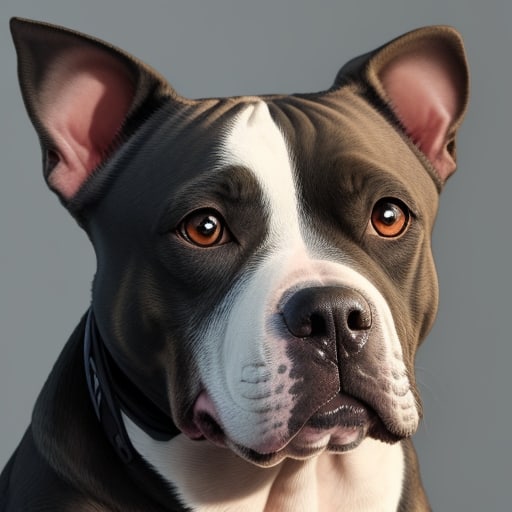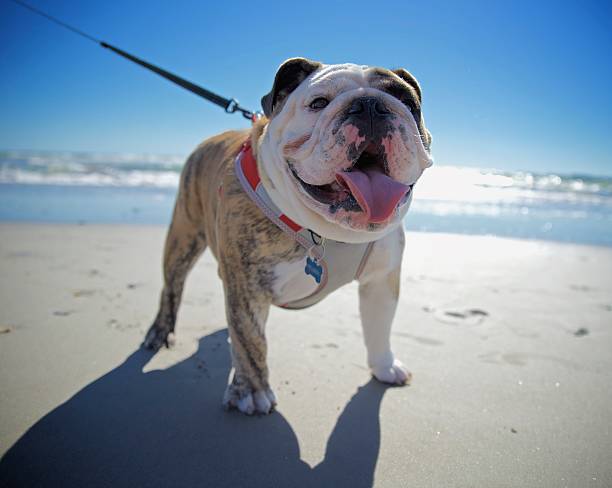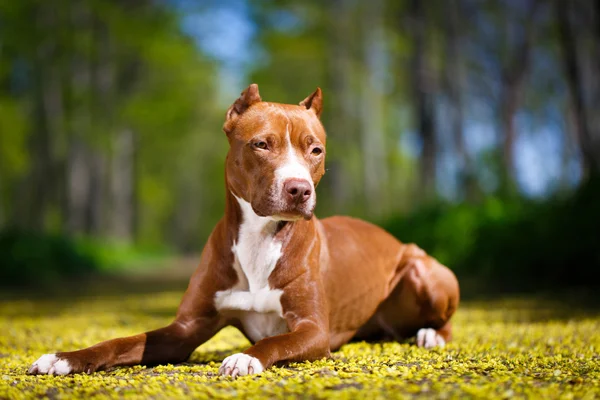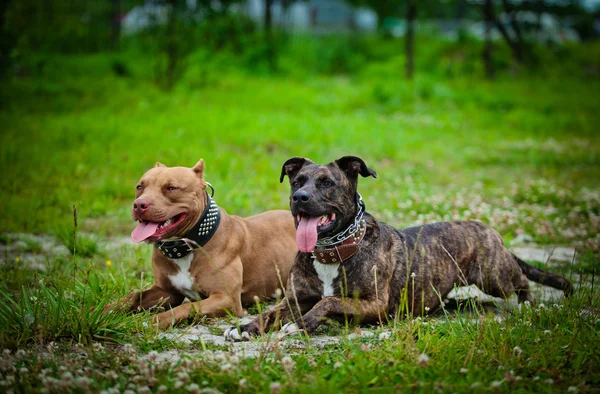The American Pit Bull Terrier, a true embodiment of athleticism and loyalty, has a special place in the hearts of dog lovers and families who appreciate determination and devotion. With its athletic physique, playful nature, and unyielding loyalty, this breed has become a treasured family member and a symbol of enduring canine spirit.

| Category (Explanation) | Breed Information |
|---|---|
| Year of Breed Conception | 19th century |
| Country of Origin | United States (Originally bred in England) |
| Weight (Male) | 35-60 lbs (16-27 kg) |
| Weight (Female) | 30-50 lbs (14-23 kg) |
| Coat Type | Short, smooth |
| Color Variations | Various, including brindle, fawn, black, and more |
| Shedding Level (Low, Moderate, High) | Low |
| Height (cm & in) | 17-21 inches (43-53 cm) |
| Breed Size | Medium |
| Trainability (Low, Moderate, High) | High |
| Mental Needs (Low, Moderate, High) | Moderate |
| Intelligence Level (Low, Moderate, High) | High |
| Energy Level (Low, Moderate, High) | High |
| Agility (Low, Moderate, High) | High |
| Loyalty (Low, Moderate, High) | High |
| Playfulness (Low, Moderate, High) | High |
| Exercise Needs | Regular vigorous exercise |
| Guarding Proficiency (Low, Moderate, High) | Moderate |
| Sociability with Children (Low, Moderate, High) | High |
| Barking Level (Low, Moderate, High) | Low to moderate |
| Digging Tendency (Low, Moderate, High) | Low to moderate |
| Destructive Behavior (Low, Moderate, High) | Low to moderate |
| Drooling Level (Low, Moderate, High) | Low |
| Obedience Level (Low, Moderate, High) | Moderate to high |
| Apartment Friendly (Yes/No) | Yes, with proper exercise and mental stimulation |
| Inherent Prey Drive | Moderate |
| Physical Risk to Others (Low, Moderate, High) | Low |
| Travel Fatality Risk (Low, Moderate, High) | Low |
| Allergen Potential | Low (considered hypoallergenic) |
| Health Concerns (List of Common Health Concerns) | Hip Dysplasia, Skin Issues, Heart Disease |
| Average Life Expectancy (Life Expectancy in Years) | 12-16 years |










































































Woof Mastery is reader supported and our articles may contain affiliate links.
Instead of running third party ads that we have no control of we only use links from high-quality companies we are directly partnered with. Making use of these links come at no cost to you our reader, and in many cases have the extra benefit of discounted rates or sign up bonuses.
If you’re interested you can read more about our affiliate policy here.
We appreciate your support and always insure that the products and services we recommend are high-quality, helpful and relevant to the subject at hand!
The American Pit Bull Terrier’s history is an epic narrative of their working heritage and unwavering loyalty. In the early 19th century, these dogs were specifically bred for bull-baiting and later as catch dogs for livestock. Their physical prowess, determination, and loyalty made them invaluable to farmers and homesteaders in the United States.
Despite their challenging history, Pit Bull Terrier enthusiasts placed a spotlight on their loyalty and affectionate nature. The breed’s transition from being dedicated working dogs to cherished family members embodies their resilience and commitment. Today, American Pit Bull Terriers continue to be celebrated for their strength, loyalty, and their unyielding spirit, symbolizing the enduring bond between humans and dogs.

What sets the American Pit Bull Terrier apart is its incredible loyalty and determination. These dogs have a muscular build and a history of being catch dogs and farm helpers.
However, their true special quality lies in their unwavering loyalty to their families. American Pit Bull Terriers are known for their love of people, often described as affectionate and people-oriented. Their ability to combine strength and loyalty makes them truly special companions.
American Pit Bull Terriers have a history of being versatile working dogs and family pets. They are known for their strength and misunderstood affection.
American Pit Bull Terriers are renowned for their friendly and outgoing personalities. They are affectionate towards their families and have a strong desire to please. Their intelligence and enthusiasm make them responsive to training, and they often exhibit a loving and dependable nature. These dogs are known for their zest for life and are often described as “people-loving” dogs.
They enjoy being at the center of family activities and are often seen as affectionate and playful companions. American Pit Bull Terriers have a unique ability to form deep bonds with their owners and are known for their loyalty and devotion.
Their muscular build and powerful appearance may belie their affectionate nature, but they are truly gentle souls when it comes to interacting with their loved ones. They thrive on companionship and actively seek opportunities to engage with their families.
American Pit Bull Terriers are renowned for their loyalty, affection, and robust physicality. They may exhibit protective instincts that require attention through training and socialization to maintain a balanced temperament.
Territorial behavior and occasional stubbornness can be addressed with consistent training efforts. Leash training is vital due to their strength and athleticism.
With proper socialization, American Pit Bull Terriers are often friendly with other dogs and people, reflecting their well-adjusted and loving nature. They are known for forming strong bonds with their families, making them loyal and reliable companions. Their physical prowess and loving disposition make them a unique and cherished breed for many families.
American Pit Bull Terriers, often referred to as Pit Bulls, are medium-sized dogs known for their muscular and athletic build. They possess a square-shaped head with a broad, well-defined jaw and strong cheeks, giving them a determined and alert expression.
Their eyes are typically round and expressive, showcasing their intelligence. Ears may be cropped or left natural, based on individual preference.
These dogs have a short, dense coat that comes in various colors, often with striking patterns. This coat not only enhances their powerful and agile physique but also complements their confident and playful temperament.
American Pit Bull Terriers possess a muscular neck, leading to a broad chest and sturdy, straight legs. Their tail is typically short and tapers.
In terms of size, males typically stand between 18 to 21 inches (46-53 cm) at the shoulder, while females are slightly smaller. Weight ranges from 35 to 60 pounds (16-27 kg) for males, with females being lighter.
Overall, American Pit Bull Terriers project a confident and athletic presence. They have a history as loyal and devoted companions, and their appearance exudes strength, agility, and a friendly disposition, making them a beloved choice for families seeking an active and loving pet.
American Pit Bull Terriers exhibit a range of color varieties that enhance their strong and athletic appearance. The most common color variations include:
American Pit Bull Terriers also have a low shedding level. They are not heavy shedders, and their shedding is typically minimal year-round. Occasional grooming and brushing with a soft bristle brush can help control shedding and keep their coat in good condition.
Factors that can affect shedding in American Pit Bull Terriers can be influenced by genetics, diet, and allergies. Identifying and managing allergies through proper nutrition and veterinary care can help reduce shedding. Regular exercise and mental stimulation are essential for overall health and coat care.
American Pit Bull Terriers have short, smooth coats that are easy to maintain.
Brushing: Regular brushing once or twice a week helps reduce shedding and keeps their coat in good condition.
Bathing: Bathe them only when necessary, as their skin is sensitive. Use a mild dog shampoo and ensure thorough rinsing and drying.
Ears: Clean their ears regularly to prevent wax buildup or infections. Use a damp cotton ball or a veterinarian-recommended ear cleaning solution.
Nails: Keep their nails trimmed to a comfortable length to prevent discomfort.
Teeth: Brush their teeth regularly to maintain good oral hygiene and prevent dental issues. Dental chews or toys can assist with oral care.
Eye Care: Watch for signs of eye irritation or discharge and clean around the eyes if necessary with a damp cloth.
American Pit Bull Terriers have a high activity level. They are known for their athleticism and agility. Here are some key points to consider about their activity level:
American Pit Bull Terriers possess a moderate level of intelligence, complemented by their strength and agility. Their intellect is multifaceted:
American Pit Bull Terriers may not rank at the top in problem-solving or obedience, but their intelligence, combined with their loyalty and protective instincts, makes them dependable family pets and guardians. They have a strong sense of duty to their loved ones and are always prepared to watch over and safeguard them. Proper training and socialization are essential for their well-rounded behavior.
American Pit Bull Terriers have a keen intellect. Engage them with interactive toys, training exercises, or games to stimulate their minds.
Social Interaction: They are affectionate and form strong bonds with their families, requiring daily interaction to maintain emotional well-being.
Exercise: Engaging in regular physical activities like walks or play sessions keeps their mind and body active and helps manage their energy.
Training and Obedience: Positive reinforcement training sessions enhance their bond with the owner and ensure they grow up to be well-behaved pets.
Routine and Structure: Maintaining a consistent daily schedule provides a sense of security and stability to the American Pit Bull Terrier.
Affection and Attention: Known for their loyalty, they thrive on regular love and attention from their family members.
Socialization: Early exposure to various situations and creatures is vital to ensure they grow up as sociable and confident dogs.
Safe Environment: Providing a comfortable home space ensures they can relax without feeling threatened or anxious.
Consistency: Adherence to regular routines and consistent training techniques helps in managing their temperament and ensuring their contentment.
Enter The Woof Mastery

Before welcoming an American Pit Bull Terrier into your home, it’s crucial to recognize their needs. These dogs are known for their strength and determination. They require regular exercise and mental stimulation to thrive. Training and socialization are vital to ensure they are well-behaved.
Be prepared for breed-specific laws in your area, as some places may have restrictions on owning them. Responsible ownership involves providing love, attention, and a secure environment for these loyal and energetic companions.
American Pit Bull Terriers, often at the center of debate due to misrepresentation, have the potential to pose a physical danger if not appropriately socialized, trained, or managed. A dog’s behavior leans on factors like temperament, upbringing, training, and owner commitment. Here’s their potential danger overview:
American Pit Bull Terriers are renowned for their friendly and outgoing personalities. They are affectionate towards their families and have a strong desire to please. Their intelligence and enthusiasm make them responsive to training, and they often exhibit a loving and dependable nature.
These dogs are known for their zest for life and are often described as “people-loving” dogs. They enjoy being at the center of family activities and are often seen as affectionate and playful companions. American Pit Bull Terriers have a unique ability to form deep bonds with their owners and are known for their loyalty and devotion.
Their muscular build and powerful appearance may belie their affectionate nature, but they are truly gentle souls when it comes to interacting with their loved ones. They thrive on companionship and actively seek opportunities to engage with their families.
American Pit Bull Terriers, renowned for their loyalty, energy, and intelligence, also exhibit a spectrum of swimming abilities. Here are some factors to consider regarding their ability to swim:
While many American Pit Bull Terriers can be proficient swimmers and genuinely enjoy the experience, it’s vital to stay attuned to your dog’s signals and always prioritize safety.
American Pit Bull Terriers, like their canine counterparts, have their own repertoire of sounds they use to communicate. Here’s a glimpse into their vocal world:
For American Pit Bull Terrier owners, understanding their dog’s vocalizations and the reasons behind them is crucial. While many of their sounds are a part of their expressive nature, others might hint at discomfort or specific needs. Positive reinforcement techniques can be invaluable in managing their vocal behavior.
American Pit Bull Terriers thrive in homes where they receive love, structure, and opportunities for socialization. Here are some ideal living conditions for American Pit Bull Terriers:
Challenges:
When it comes to travel fatality risk for American Pit Bull Terriers, consider the following potential constraints specific to this breed:
By addressing these potential constraints and taking necessary precautions, you can help ensure the safe travel of your American Pit Bull Terrier and minimize travel-related risks.
American Pit Bull Terriers are susceptible to specific health concerns. While not all individuals will experience these issues, it’s essential for American Pit Bull Terrier owners to be aware of potential health problems and work with veterinarians to maintain their pets’ well-being. Common health concerns for this breed include:
For the health and well-being of American Pit Bull Terriers, consistent veterinary care, appropriate nutrition, and regular exercise are imperative. A close association with a trusted vet is beneficial for early problem detection.
Proper nutrition is essential for the health and well-being of American Pit Bull Terriers. Here are some nutritional habits and best practices to consider for this breed:
Breed-Specific Laws (BSL): American Pit Bull Terriers are frequently targets of breed-specific laws (BSL) due to the public’s perception and incidents linked to improperly trained or handled dogs.
Types of Restrictions: These range from spaying/neutering obligations, specialized licensing, liability insurance requirements, muzzling protocols in public, and often, outright bans.
Rationale for BSL: Public safety worries, often magnified by media, have placed this breed under intense scrutiny. While they can be loyal companions, mismanagement can lead to problems.
Controversy: BSL’s efficacy and fairness are debated, with many championing responsible ownership and proper training over breed bans.
Local Regulations: Those considering an American Pit Bull Terrier should be aware of and adhere to local breed-specific regulations.
Woof Mastery is reader supported and our articles may contain affiliate links.
Instead of running third party ads that we have no control of we only use links from high-quality companies we are directly partnered with. Making use of these links come at no cost to you our reader, and in many cases have the extra benefit of discounted rates or sign up bonuses.
If you’re interested you can read more about our affiliate policy here.
We appreciate your support and always insure that the products and services we recommend are high-quality, helpful and relevant to the subject at hand!
Myth 1: American Pit Bull Terriers are Aggressive by Nature
Myth 2: They Are Always Good Guard Dogs
Myth 3: They are Not Good with Children
Myth 4: They Can’t Live in Apartments
Myth 5: They are All the Same Size
Myth 6: They are Always Dog-Aggressive
Myth 7: They Don’t Require Training
Myth 8: They are Lazy Dogs
Myth 9: They are Unhealthy Dogs
Myth 10: They Can’t Tolerate Cold Weather
The American Pit Bull Terrier holds cultural significance in various contexts:
While there may not be as many famous American Pit Bull Terrier owners as there are for other dog breeds, here are a few notable individuals who have been associated with American Pit Bull Terriers:
American Pit Bull Terriers, like many other dog breeds, have faced several threats and challenges over the years. Some of the significant threats and issues that have affected the breed include:
The American Pit Bull Terrier is believed to have been developed from a combination of various breeds, with the primary ancestors being the early Bulldog breeds and terriers. The breed’s development was influenced by the need for a versatile working and fighting dog. The specific breeds and strains that contributed to the American Pit Bull Terrier’s development include:
American Pit Bull Terriers are known for their resilience and affectionate nature. Their muscular build and loving disposition make them exceptional companions. These dogs thrive in various living conditions and require only minimal grooming. Their intelligence and eagerness to please make them excel in various activities and training.
While they are strong and athletic, they are also gentle and patient, particularly with children. American Pit Bull Terriers quickly form deep bonds with their human companions, providing unwavering loyalty and devotion. Their distinctive appearance and zest for life add a unique charm to every household. These versatile dogs effortlessly transition from beloved family pets to diligent working dogs.
Above all, they offer profound and unconditional love, becoming treasured family members who enrich lives with their unwavering companionship. Invite an American Pit Bull Terrier into your life and discover the incredible affection and devotion they have to offer.